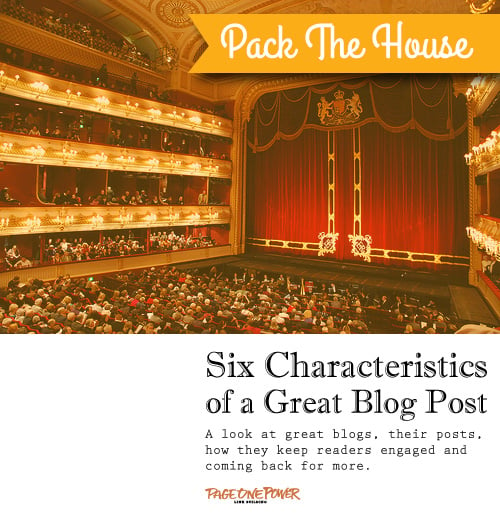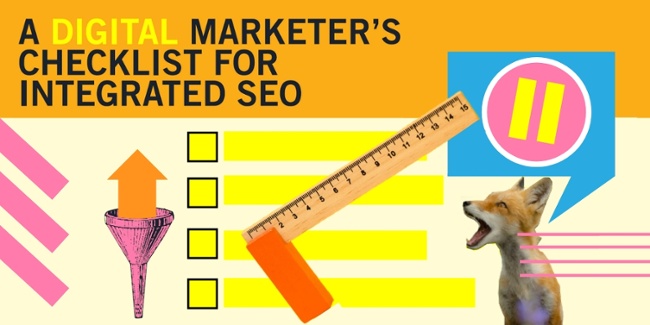Nearly everyone understands the benefits of blogging in today’s business world.
A well-managed blog is fundamental to online visibility. Its ability to create a presence, a sense of community, and an avenue of direct communication to your specific target audience is invaluable.
A blog gives companies an opportunity to work on their branding, establish themselves as an authority, and release company news directly to their clients and customers.
Having a strong, active, and social online presence has become an absolute must in this new era of business. However, a blog is only as powerful as the person wielding it; better to not blog at all than to have an out of date, poorly written, or lackluster blog. An ill-managed blog is as powerfully negative as a well-managed blog is positive.
Let's take a look at 6 characteristics of a great blogs.
Good Blogs Build Relationships
The entire point of a blog is to build a relationship with an audience. There’s no point writing a blog if no one is going to read it. A strong blog fosters a person-to-person connection, with real human interaction. A great blog transfers knowledge, ideas, and experiences.
Compelling content makes or breaks a blog. By publishing your blog you’re stating that what you have to say is worth not only your own time to write and publish, but worth others' time to read. And, if your published posts aren't up to snuff, your readers will be dissatisfied and end the relationship.
So if you are passionate, excited, and ready to start a blog here are some guidelines for creating cogent, intelligent, and powerful content for your blog.
1) Make Your Post Pertinent
No matter how well-written, or how informative the blog post, without relevant content it is wasted breath.
Relevance should be your number one priority when writing a blog post. Know your audience and gauge what will not only be appropriate, but pertinent. Do some keyword research to find important information that's missing, and share your unique perspective.
Need help integrating SEO into your marketing plan? We are here to help! Download our free checklist to expand your knowledge on how to integrate keyword research and content marketing.
This is absolutely vital for building authority within your chosen niche. If your company specializes in the food industry, your readers will likely be uninterested in a blog post about the latest fashion in footwear. Likely, you’ll lose branding power as well.
2) Include Useful Information
It’s not enough that a blog post be relevant to a subject. It also needs to be useful and important information. Your blog should aim to help and educate your audience, offering valuable takeaways. People appreciate information they can do something with, and will return to your blog if you consistently offer posts that are not only relevant, but useful.
Why do most blogs fail? The simple truth is most blogs are too self-absorbed.
It is not uncommon to find blogs that become a podium for the authors every thought and feeling. This pulls them away from solid, useful content, and suddenly the blog flounders and fails. Check out this good-natured video about the reason why blogs fail:
3) Make Your Post Engaging
A blog post must be well-written. And it’s not enough to have perfect grammar and spelling; it needs to be personal, interesting, and interactive.
Try to let your personality shine through in your writing. Don’t be afraid to write in a conversational tone. Personal stories and anecdotes are a great way to make a blog post more engaging. Southwest’s blog does a solid job of being personable.
4) Spark Discussion
This goes along with engaging your reader. It is extremely important to generate as much conversation and discussion as possible in your blog. Great posts should generate discussion, so don’t forget to include your readers.
Ask for feedback, thoughts, opinions, or even just comments. Include a call to action at the end of article to garner a response. And don’t forget to participate once the discussion starts; respond to comments, emails, and questions!
5) Keep it Readable
We’ve all seen the blog posts known as the old wall o’ text. No one reads these. They can be the best, most interesting, well-written articles, but if they’re not easily digestable they get skipped over. This isn’t prose, so keeps your thoughts succinct and to the point.
Bullets, lists, graphs, and images are a great way to make sure your content is easy to read. Always preview your work before you publish, and make sure it’s scannable. Check out this blog for a great job of making a hard to write subject extremely readable.
6) Appropriate Length
This is a bit trickier. Some say good blog posts should hover right around 500 words. Others say anything less than 1,000 doesn't cut it.
The truth is both simpler and more complex.
A blog post should be as long as it needs to be. By this, I mean that it should be as long as it takes for you to succinctly and clearly explain your idea, concept or thought.
If you can write a well thought out, complete article in 400 words, that’s great. If you can keep it interesting, engaging, relevant and informative all the way to 1,500 words, then it’s still a great blog post.
In the end, as long as you offer quality, pertinent information in a readable and engaging manner consistently your blog should do well, hopefully fostering a sense of online community along with helping build a personal connection with your readers.
If you want to take your blog posts to the next level, you can download this free checklist to make sure your content is optimized to perform in organic search.




